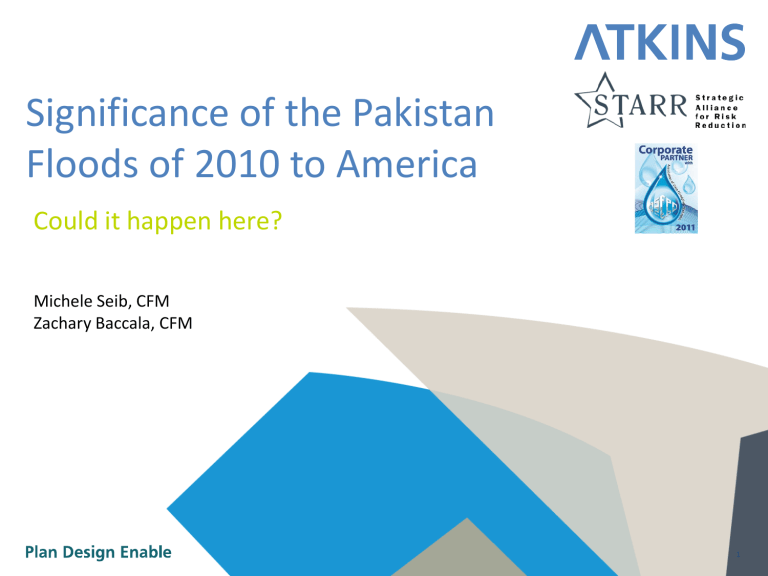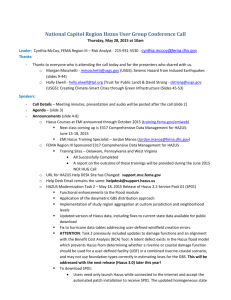Hazus Analysis

Significance of the Pakistan
Floods of 2010 to America
Could it happen here?
Michele Seib, CFM
Zachary Baccala, CFM
1
Index of Analysis
• Background of floods along Indus River
• Hydrology of the Pakistan flood of 2010
• Similarities in U.S. Watersheds
• Hazus Analysis of the Missouri River
• Impact Study – Could a similar catastrophe happen here?
2
Background – Indus River Facts
• Primary source of agricultural water supply
• Provides 45% of electricity for Pakistan
• Majority of population live in the watershed http://media-cdn.tripadvisor.com/media/photos/01/24/f8/5e/indus-river-and-fields.jpg obtained 5/15/2011 http://1.bp.blogspot.com/-
2YKQLSdquC0/TaGEbBL0NfI/AAAAAAAAEbk/RUTiBuswuSU/s1600/Indus
+River+Pakistan+by+all+about+pakistran+%252819%2529.jpg obtained
5/15/2011
3
Background – 2010 Flood Facts
According to the United Nations OCHA,
• 17.2 million people directly affected
• 1,539 lives claimed
• 1.2 million homes damaged or destroyed
• 3.2 million hectares of farmland destroyed
• Damaged 7,820 schools
• Massive infrastructure damage
Photo of flooding in
Muzaffargarh
(AFP/Getty Images)
4
Background – Planning Factors
Location of
Development
Lack of maintenance
Lack of storage
Flood warning system
FLOODING http://www.floodrelief.us/wpcontent/uploads/2010/08/pakistan-flood-2009-8-
17-12-41-15.jpg obtained 05/15/2011
5
Background – Flood Distribution based on: http://www.spiegel.de/panorama/0,1518,711885,00.html
, Google Earth and Times Atlas, flooding zones as of 2010-8-26
Hydrology – Indus River
• Precipitation and temperature primary contributors
• Links Himalayans and groundwater from Indus alluvium fans
• Large number of dams and barrages
• Total Drainage area = 450,000 square miles
7
Hydrology – Flood Disaster Factors
Duration of monsoon season
Lack of maintenance
Higher than normal precipitation Design
Criteria of structures http://www.inmysense.com/wpcontent/uploads/2010/11/flood-pakistan.jpg
8
Hydrology – Indus River
Tarbela
Kalabaugh
Chashma
Guddu
Kotri
Taunsa
Sukkur http://ancien.riob.org/ag2000/pakistan.htm
9
Hydrology – Historical Peaks
Site
Tarbela
Kalabagh
Design cfs MaximumQ cfs
1,500,000
950,000
832,000
937,453
Date
July 30 2010
July 30 2010
2010 Q cfs
833,000
937,453
Chashma
Taunsa
950,000
1,100,000
1,038,873
959,991
Guddu
Sukkur
1,200,000
1,500,000
1,199,672
1,166,574
Kotri 875,000 980,329
Data obtain from the Pakistan Meteorology Department
August 1 2010
August 2 2010
August 15 1976
August 15 1986
August 14 1986
1,038,873
959,991
1,148,738
1,130,995
964,897
10
Hydrology – Study Locations
Tarbela
65,000 sq miles
833,000 cfs
Taunsa
180,000 sq miles
959,991 cfs
Guddu
293,300 sq miles
1,130,000 cfs
11
Similarities – US Watersheds
Missouri River Basin
• Average discharge 86,340 cfs
• 529,350 square miles
• Sourced by several springs http://www.nwd-mr.usace.army.mil/rcc/images/mrr_map_1.jpg
12
Similarities – US Watersheds
Fort Peck Dam, MT Sioux City, IA
Bismark, ND
Hermann, MO
13
Similarities – Gage Pairs
Tarbela
65,000 sq miles
833,000 cfs
Fort Peck Dam Montana
57,566 sq miles
Q100 = 45,620 cfs
Q500= 58,770 cfs
Historical Peak= 51,000 cfs (1946)
Taunsa
180,000 sq miles
959,991 cfs
Bismark North Dakota
186,400 sq miles
Q100 = 325,200 cfs
Q500=548,500 cfs
Historical Peak= 500,000 cfs (1952)
Guddu
293,300 sq miles
1,130,000cfs
Sioux City Iowa
314,600 sq miles
Q100 = 445,600 cfs
Q500=571,100 cfs
Historical Peak= 441,000 cfs (1952)
14
Similarities – Gage Pair
Kotri
*450,000 sq miles
964,000 cfs
Hermann Missouri
573,566 sq miles
Q100 = 703,900 cfs
Q500= 862,100 cfs
Historical Peak= 750,000 cfs (1993)
15
Hydrologically speaking, could an event happen along the Missouri River?
16
Hazus Modelled Losses
17
Hazus
• Hazus MR5
• DEMs from USGS Seamless
• DEMs for Canada from SRTM 90mtr data
• Resampled to 30mtr
• 20 sq mile drainage area used for stream network creation
• Single Discharge Methodology
• Section 1: 833,000
• Section 2: 959,991
• Section 3: 1,140,000
18
Hazus – Selected Communities
• Bismarck, North Dakota
• 1952 Floods
• 27.9 feet, 200 homes destroyed
• 300 head of cattle
• Modeled Flood (Section 2)
• 31 feet
• 7,124 homes impacted
• 3,788 substantially damage
• $1,232,086,000 Total Loss
• Mandan, ND also heavily impacted
19
Hazus – Selected Communities
• Sioux City, Iowa
• 1952 Floods
• 24.3 feet
• $3,264,000 in damages
• Modeled Flood (Section 3)
• 33 feet
• 5,240 homes impacted
• 3,246 substantially damage
• $1,694,734,000 Total Loss
• Dakota County, NE also heavily impacted
20
Hazus – Selected Communities
• Omaha, Nebraska
• 1952 Flood
• 30.25 feet
• $445,018,700 in damages
• 414,000 cfs
• 5 miles wide
• Altered course of river
• Modeled Flood (Section 3)
• 33 feet
• 9,463 homes impacted
• 7,665 substantially damage
• $2,742,164,000 Total Loss
• Almost 7 miles wide
• 1,140,000 cfs
21
Hazus Agricultural Analysis
• Parameter and Losses
• Agriculture Parameter: May 1 st
• Agricultural Losses Totaling $352,450,000
• Majority Corn, Soybeans, Wheat and Oats
$45 927 074
$42 089 290
$45 489 204
$6 464 674
Corn
Soybeans
Wheat
Oats
22
• General Building Stock
• $7,070,296,000 Total Losses
• Shelters
• Displaced Population: 106,845
• Short Term Needs: 93,088
• Schools
• 59 schools
• $216,594,290 Building Damage
Hazus
50
45
40
35
30
25
20
15
10
5
0
Nebraska
Building Loss Ratio
MT Iowa South Dakota
23
Other Impacts
• Transportation Systems
• Airports
• 4 large airports, including Eppley Airfield in Omaha,
Nebraska and Sioux Gateway Airport (Colonel Bud Day
Field) in Sioux City, Iowa
• Roads
• Rails
• 235 Major Highway segments
• 32 of Highway crossings
• 1,085 miles inundated
• 8 rail crossings
24
Environmental Hazards
• Over 7500 Public Water Source wells
• TRI Sites
• 173 Sites
• Agricultural, Fuel Depots,
Industrial chemicals
• Waste Water Treatment Facilities
• Over 40
• 16 Classified as Major
25
Environmental Hazards
• Over 7500 Public Water Source wells
• TRI Sites
• 173 Sites
• Agricultural, Fuel Depots,
Industrial chemicals
• Waste Water Treatment Facilities
• Over 40
• 16 Classified as Major
26
Could such an event happen in the US?
• From an engineering perspective
• Yes, but only at the mouth
• From a economic perspective
• Relief Aid
• Income/Educational differences
• Government Organizations
• From a quality of life perspective
27
Questions
• Michele Seib: michele.seib@atkinsglobal.com
• Zachary Baccala: zachary.baccala@atkinsglobal.com
28













